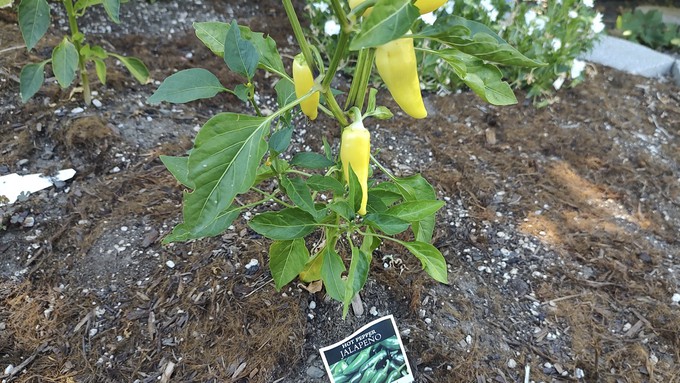
Cool spring challenged seedling growth, no matter the pepper variety

This not-jalapeno is another mislabeled pepper in the summer of #jalapenogate. Laura Litzinger Hafner via Facebook
It’s been a tough summer for peppers – no matter the variety.
First, there’s Jalapenogate. Thousands of gardeners in several states are dealing with mislabeled jalapeno (or purple bell) plants. Instead of producing what their buyers expected, these plants grew yellow fruit that looks like a banana or wax pepper (and definitely not a jalapeno).
“I planted jalapenos, habaneros, serranos, Anaheims, green bells, yellow bells, and red bells,” wrote SDG reader Hollie Snider of Colorado on our Facebook page. “One of my jalapenos appears to be either a golden jalapeno or a Hungarian wax. Another jalapeno appears to be a banana pepper.”
(Read more about Jalapenogate here: https://sacdigsgardening.californialocal.com/article/45405-jalapenogate-is-real/)
It’s not just jalapenos that have had a head-scratching summer; all sorts of peppers have not enjoyed 2023.
The trouble started with the cool spring temperatures, observed Evan Hanson, retail nursery manager at Big Oak Nursery in Elk Grove. “Our spring peppers didn’t grow well. We had a lot of problems with them growing. They just didn’t do anything. As a result, we didn’t have the hot peppers – such as Carolina Reaper and ghost peppers – like we usually do.”
Instead of developing, the baby pepper plants damped off or seemed stunted. It was an issue experienced by other local pepper growers, too.
Big Oak, which grows many of its own veggies from seed, avoided selling the mislabeled jalapenos, at least so far. Nurseries and customers can’t tell for sure until the peppers form fruit. “So far so good,” Hanson said.
But many pepper buyers found out the hard way that their “jalapenos” weren’t what they were labeled. For example, a quick survey of pepper plants at Fremont Community Garden in Midtown Sacramento found several peppers with “jalapeno” plant tags that were clearly bearing pale yellow peppers.
Mixing up pepper seed is an easy mistake, even for experienced growers.
“Pepper seeds look alike,” noted radio host-turned-podcaster Farmer Fred Hoffman, a lifetime UCCE master gardener and host of “Garden Basics with Farmer Fred.”
Pepper seed needs warm temperatures – above 80 degrees – to germinate and warm soil (above 55 degrees) to grow outdoors. That’s why local growers usually start their peppers indoors in February. Pepper seedlings take several weeks of development before they’re ready to transplant outside.
That need for warmth and a long growth period until maturity can make peppers challenging under the best of growing conditions. Although peppers need sun, they’re easily sunburned. The challenge now is to keep them semi-shaded during scorching summer days and evenly irrigated.
For more on peppers, check out these tips from the UCCE master gardeners: https://ipm.ucanr.edu/agriculture/peppers/
Comments
0 comments have been posted.Sacramento Digs Gardening to your inbox.
Sites We Like
Garden Checklist for week of April 21
This week there’s plenty to keep gardeners busy. With no rain in the immediate forecast, remember to irrigate any new transplants.
* Weed, weed, weed! Get them before they flower and go to seed.
* April is the last chance to plant citrus trees such as dwarf orange, lemon and kumquat. These trees also look good in landscaping and provide fresh fruit in winter.
* Smell orange blossoms? Feed citrus trees with a low dose of balanced fertilizer (such as 10-10-10) during bloom to help set fruit. Keep an eye out for ants.
* Apply slow-release fertilizer to the lawn.
* Thoroughly clean debris from the bottom of outdoor ponds or fountains.
* Spring brings a flush of rapid growth, and that means your garden is really hungry. Feed shrubs and trees with a slow-release fertilizer. Or mulch with a 1-inch layer of compost.
* Azaleas and camellias looking a little yellow? If leaves are turning yellow between the veins, give them a boost with chelated iron.
* Trim dead flowers but not leaves from spring-flowering bulbs such as daffodils and tulips. Those leaves gather energy to create next year's flowers. Also, give the bulbs a fertilizer boost after bloom.
* Pinch chrysanthemums back to 12 inches for fall flowers. Cut old stems to the ground.
* Mulch around plants to conserve moisture and control weeds.
* From seed, plant beans, beets, cantaloupes, carrots, corn, cucumbers, melons, radishes and squash.
* Plant onion sets.
* In the flower garden, plant seeds for asters, cosmos, celosia, marigolds, salvia, sunflowers and zinnias.
* Transplant petunias, zinnias, geraniums and other summer bloomers.
* Plant perennials and dahlia tubers for summer bloom.
* Mid to late April is about the last chance to plant summer bulbs, such as gladiolus and tuberous begonias.
* Transplant lettuce seedlings. Choose varieties that mature quickly such as loose leaf.